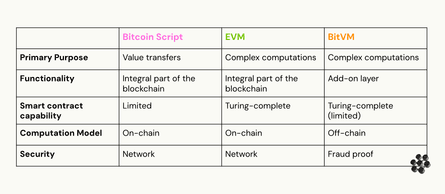Crypto developers will be deeply familiar with the Ethereum Virtual Machine, which plays an instrumental role in delivering smart contracts to the masses. In late 2023, a new computing paradigm called BitVM was proposed by Robin Linus to help make the Bitcoin blockchain more scalable and versatile.
But what are the differences between BitVM and EVM, and how do these distinctions affect developers seeking to build dApps for everyday use? Here, we’re going to offer a side-by-side comparison of both virtual machines.
But first, if you’re still wondering what BitVM is to begin with, then read this explainer article.
Purpose
EVM is an execution engine that is part of the Ethereum blockchain consensus. It runs the smart contracts between multiple parties after the consensus mechanism allows the parties to agree on state transitions. Thus, it eliminates the need for a middleman. It also ensures the network remains updated once new blocks are validated.
BitVM is also designed to supercharge Bitcoin’s versatility by enabling the building of layer 2 solutions that can execute smart contracts on top of Bitcoin.
Functionality
EVM is an integral part of the Ethereum blockchain, and it allows Ethereum’s on-chain computational model. The design of the EVM supports complex operations, making it a versatile platform for a wide range of decentralized applications
However, as it is an integral part of the blockchain, this means that Ethereum would not exist without EVM.
On the other hand, BitVM is an additional layer to the Bitcoin blockchain built as a challenge-response game model that involves off-chain computation and verification, with the ability to enforce penalties in case of fraudulent claims through on-chain dispute resolution mechanisms.
Scalability and Operation
This brings us neatly to a comparison of how both virtual machines operate.
Since EVM operates on-chain, it boosts the transparency of the transactions because all transactions are immutably recorded on a public ledger.
However, this brings downsides. Despite Ethereum’s switch to Proof-of-Stake, congestion and eye-watering gas fees have remained a persistent issue at peak times.
While upgrades have been rolled out to alleviate this problem, with a proliferation of Layer 2 networks to pick up the slack, scalability issues often price everyday users out of using the mainnet.
By contrast, BitVM processes complex computations away from the main blockchain because Bitcoin’s script, in its native design, is deliberately restricted in terms of flow control and “expressiveness’ to maintain chain security.
This added layer introduces the potential for a wide range of applications bridging BTC to foreign chains, enabling trustless bridges to the Bitcoin blockchain.
So in a nutshell, comparing EVM, BitVM and Bitcoin script you’ll find:
What are the use cases for BitVM?
We’re still in the early days of understanding the potential applications for BitVM, but it’s clear to see this infrastructure can boost Bitcoin’s utility and adoption.
For example, this could pave the way for creating layer 2 solutions for automated payments — even if there are a high number of transactions to process. This could be especially attractive for businesses who currently have to depend on Ethereum for this, despite the often prohibitive cost.
BitVM could also open the doors to Bitcoin being more than just a store of value. Instead, Bitcoin may be used more widely for remittances, savings, loans and other financial services — and even tackle a common criticism that Proof-of-Work is energy intensive and bad for the environment.
Did you enjoy reading this? If yes, join the conversation on Discord.

